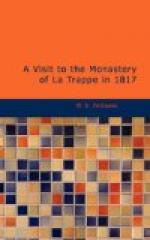The Prussians in 1815 occupied this country, and notwithstanding M. Boderie was absent at that time serving in the body guard of Louis XVIII, whom he had accompanied in his retreat to Ghent, they plundered him of every article, not even leaving his wife a change of linen. The numerous accounts I have heard from people of respectability and loyalty, of the treatment experienced from the Prussians, excites the greatest regret that they were not able to distinguish the innocent from the guilty. Many families have been ruined, or greatly distressed in their circumstances who were devoted to the cause of their Sovereign. Such are the inevitable consequences of war!
The Val-Dieu extends upwards of three miles in length, surrounded by almost impenetrable woods, except where paths have been cut. It has three lakes, one communicating with the other, containing great quantities of fish. The Monastery, it is evident from the remains of its ruins, and from the boundary wall, still entire, must have been of prodigious extent. M. Boderie informed me, that the plan, of which he had seen an engraving, showed it to have been one of the most considerable in the kingdom: some idea may be formed of its former celebrity and extent by the remains of six hundred fire-places being still traceable. A colonnade surrounded the whole, forming an oblong square, in the centre of which was a jet d’eau, with several smaller ones, the basins of which are still to be seen; the space within formed a garden, with delicious walks, resembling those in the Palais Royal.
The gate-way remains perfect, excepting only that the images over the side doors have been mutilated. The one in the centre (over the great entrance) is still in excellent preservation, and appears to be finely executed: it is the figure of the Virgin Mary in gray marble, the size of life, seated, with the infant Jesus in her arms. On a scroll beneath are these letters:—
ECCE MATER
TVA.
1760.
Several old chesnut trees and elms still remain, which once formed a fine avenue in front of the building, from whence the prospect is strikingly beautiful. The eye passes over rocks, rugged, broken, and abrupt towards their summits, crowned and darkened with wood; and the narrow road winding between the trees, until it loses itself in the forest, forms a feature very gratifying to the traveller. The solitude of the place, as I viewed it at the close of day, occasioned mingled sensations of pleasure and pain. It was impossible to resist the imposing power of a situation, where every natural object was deeply tinged with the poetical character, and every remnant of architecture associated with the romance of religious feeling. I recalled and dwelt upon various passages of the poets inspired by similar scenes, and thought of the holy and enthusiastic minds which had here devoted themselves to the sublimest duties and severest sacrifices of the altar; and felt, that had I lived in those




